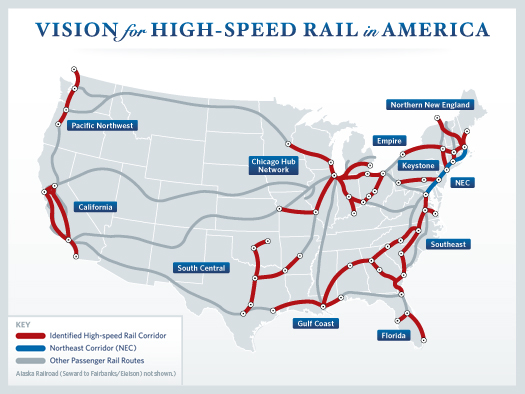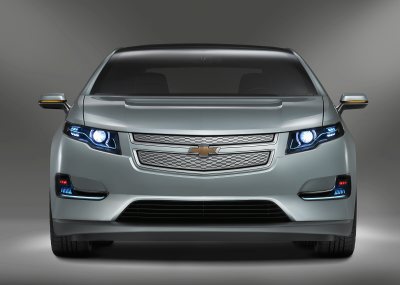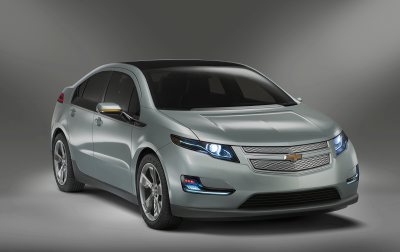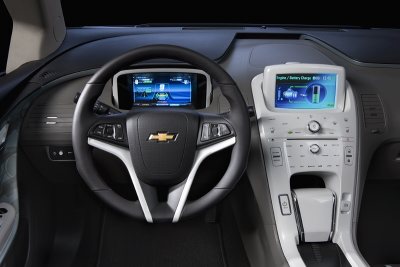
FMI, visit the FRA
Category Archives: Future Technologies
ARPA-E
President Obama has selected Steve Chu to be Energy Secretary. Chu is a seriously brilliant scientist and economist. In 2007, he served on the “Committee on Prospering in the Global Economy of the 21st Century,” which was created in response to the following Congressional query:
What are the top 10 actions, in priority order, that federal policymakers could take to enhance the science and technology enterprise so that the United States can successfully compete, prosper, and be secure in the global community of the 21st century? What strategy, with several concrete steps, could be used to implement each of those actions?
The report (of which I’ve only read the Executive Summary,) outlines major investments to be made by the Federal Government into math and science research in this country. Some hilights of the proposal include:
- Establish a national launching program for scientists by fully funding a launching program with a teaching requirement… ($20K/yr for 4 years in exchange for five years in public K-12 schools.)
- Increase federal investment in research with an emphasis on physical sciences, engineering, mathamatics, information sciences and DOD.
- Create in the DOE an agency modeled off of DARPA called ARPA-E… (Advanced Research Projects Agency-Energy.)
- Reform patent system… make things more inclusive/logical.
In support of these recommendations, the report presents some interesting statistics from a variety of disciplines. Some that caught my eye:
- General Motors spends more on healthcare than on steel.
- Chemical companies closed 70 facilities in the United States in 2004 and tagged 40 more for shutdown. Of 120 chemical plants being built around the world with price tags of $1 billion or more, one is in the United States and 50 are in China. No new refineries have been built in the United
States since 1976. - A company can hire nine factory workers in Mexico for the cost of one in America. A company can hire eight young professional engineers in India for the cost of one in America.
- The United States ranks only 12th among OECD countries in the number of broadband connections per 100 inhabitants.
- American youth spend more time watching television than in school.
- In 2001, US industry spend more on tort litigation than on research.
- “We go where the smart people are. Now our business operations are two-thirds in the U.S. and one-third overseas. But that ratio will flip over the next ten years.†—Intel Corporation spokesman Howard High
All in all not not a rosy picture. However the report is hopeful and coherent, and I strongly support it. I am particularly interested in the ARPA-E aspect of the project. That led me over to http://science.house.gov where I found out that the project had been signed into law on August 9th, 2007. Selections from the bill:
- This section establishes the Advanced Research Projects Agency – Energy (ARPA-E) within the Department of Energy. Similar to the Department of Defense’s Advanced Research Projects Agency (DARPA), this new organizational structure will support revolutionary and transformational energy research where risk and pay offs are high.
- ARPA-E shall be headed by a Director, appointed by the Secretary.
- Funds may be used for activities in any stage of the innovation spectrum from early-stage basic research to late-stage demonstration. A special emphasis should be placed on activities that serve to bridge between these stages and, ultimately, across the “valley of death†to commercial applications of the technologies.
- As with DARPA, the Director of ARPA-E will have special authority to hire program managers and other technical, managerial, and financial staff for limited terms, and at a salary commensurate with what such staff would expect to make in the private sector.
This is all part of the America COMPETES Act, the fruition of the work of Chu and the other members of the committee. Now that Chu is Energy Secretary, he will be able to appoint the Director of ARPA-E. What will be interesting to watch is how the development of this program unfolds. Since DARPA brought us the internet, one can only hope that ARPA-E will be able to deliver as revolutionary a result. This is a great step forward (likely cemented by Al Gore,) that shows a real commitment to create a 21st Century energy infrastructure that will be the envy of the world and the engine of our economy.
Obama inspires a little theorizing.
Tomorrow I take my first law school exam. Yay. In other news, I am very pleased with what Obama had to say about the automobile industry. He was tough on ‘government oversight,’ and clear about protecting the people (we’re largely less well off these days if you haven’t noticed.)
I like the way he speaks (except for the clearly affected dropped g’s (who’d of thunk?) For instance, he used the term ‘fleet’ while discussing the American automobile industry. Fleet is a technical, if somewhat militaristic term. Talk to any transportation buff and you’ll soon end up in a discussion about the fleet. Fleet is rolling stock, ‘rolling’ of course in a very Ike & Tina style. The kicker is that America is far behind at this level.
Example: While I was in the Peace Corps in Romania, CFR (the Romanian national railroad,) greatly expanded its offerings of IC level trains. IC is a European train standard for longer distance express trains (both domestic and international,) which mandates certain levels of service. Many Western countries have express interstate systems (more or less,) through their high speed rail-lines. Romania was not yet there but it was getting massive new tracking, electrical infrastructure and trainsets.
Fast forward two years to a trip from New York to New Orleans by rail. The only upgrade from cattle car coach is overnight accommodation. Unless you get a full size bedroom (which runs in the hundreds,) you get a ‘roomette.’ … Pause… time out… since when was it fashionable to brand anything with the suffix ‘ette’ ? That’s right, maybe the early to mid 1970’s, right when most of passenger rail was jettisoned by the freight carriers into an agency run by an inherently hostile governmental regime. The result was, now with apparent parallel in Detroit, lack of innovation; grudging governmental management sold with a side of diminishing returns. The American fleet is out of date. Remember how the Enterprise would sometimes come upon far more primitive species and its ships?
Since Obama is wise, he articulates that our national concept of our fleet must range beyond our military apparatus. While military driven hardware is an important segment of our fleet that generates great (and frightening) technologies, it can not be nurtured at the cost of the rest of the fleet.
3 Basic Components:
Rail – Huge re-conceptualization of the role of modern rail networks in our urban and inter-urban infrastructure. Major city pairs need new tracks, for both freight and passenger. Don’t forget: the freight railroads dumped passenger service, it was not profitable! They are separate businesses and with some major outlays they can be separately tracked. A dedicated passenger network, perhaps funded by freight taxes, would be tremendously beneficial. First, massive heavy labor public works. Creating major electrified railroads is an extremely labor intensive endeavor. The system will be a stimulus to alternative energy, perhaps through a mandate to meet X% of the system’s energy needs through region-appropriate renewables. Second, it would encourage widespread use of transportation systems that are much kinder to their surroundings. Major ancillary and wide reaching businesses implications.
Road – The Eisenhower Interstate System was a bold and not entirely unsuccessful project. I highly admire some of our major pre-interstate highways (such as Moses’ feeder Parkways in New York and Connecticut.) They were bold and radical by betting on our adoption of the automobile. Some interstates are also very important, especially for large states and regions with scattered urban and rural population centers. However, all this connectivity has its downsides; sprawl has ruined much of the interstate experience. Interstates are not kind to local enterprise, especially in urban cores. While highways were sold as great connectors, they instead became great dividers… observe the relationship between highways and public housing projects. They decreased the quality of the urban experience thereby fostering the increasing ghettoization of American urban cores.
The suburb was triumphal piece of propaganda that spoke to a real need. The problem was that it just kept going; there was no master plan, so things just sprawled. We now face an interesting demographic shift. Urban, somewhat more collective an efficient living will command a premium. Some cities will shape a nice mix: Seattle, San Francisco, Denver, Boston. Others, such as New Orleans and Las Vegas, may end up as a kind of Terry Gilliam / Mike Davis hybrid city of the future. My observation, (which I stated earlier in response to a Newsweek column dedicated to the indulgences of the nouveau-billionaire class,) is that extreme bifurcation is detrimental to any system. Though I have never been to Vegas and I have only lived in New Orleans for six months, I imagine that they might be somewhat similar in terms of fate if not character. In both, tourism is a primary engine of the economy; tourism, however, is a notoriously poor contributor to civic vitality. These cities often have grand urban cores, or at least some stately areas. These areas are often developed as privately run high security havens for the super-rich. This militarization of public space eschews a human scale and thus discourages civic interaction (just take a look at ‘brutalist’ style concrete plazas and terraces from buildings of the 1960s.) This bifurcation between indulgent fantasy and grinding poverty is an illness, and particularly un-American.
Wow, that was tangential, got to remind myself not to do that tomorrow! The point I was getting at is that road and rail are both integral to our infrastructure but must re-negotiate some precious spaces.
Fleet – So let’s have at it! Develop an electric automobile fleet with battery changing stations and strive to improve that battery technology exponentially. Lay new track and develop new rail systems which help lessen our over-dependence on the car and cheap air. And, yes, let’s still build the best damn commercial airliners. We must and can be competitive on all three fronts, but it’s going to take some pretty radical restructuring, especially for all you former Reagan Democrats. If done well, this basic stimulus will do much to improve both our operating efficiency and quality of life.
A little competition never hurt…
Although I am still betting on the Volt, I really like this. I guess, though, that I’d have to go corporate in order to afford it:
My New Car… well, in 2011 or 2012



